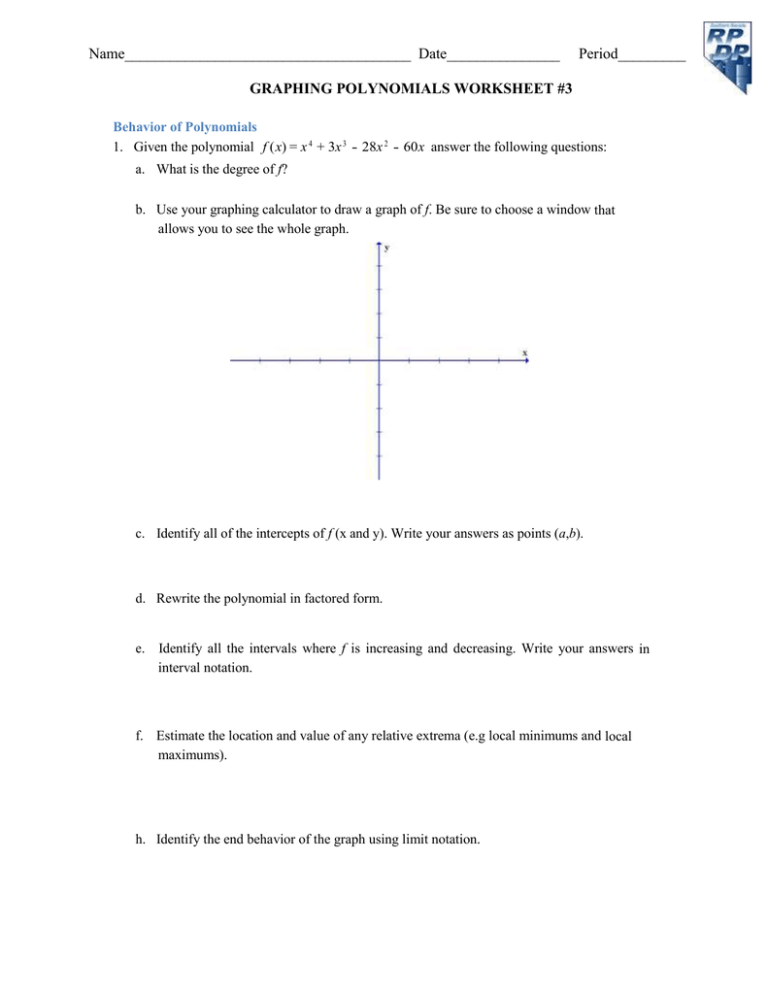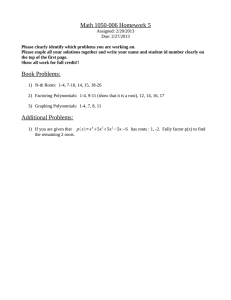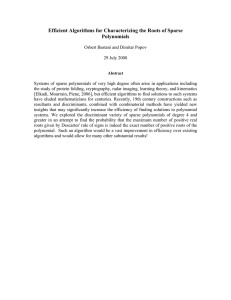Name______________________________________ Date_______________ Period_________
advertisement

Name______________________________________ Date_______________ Period_________ GRAPHING POLYNOMIALS WORKSHEET #3 Behavior of Polynomials 1. Given the polynomial f (x) = x 4 + 3x 3 - 28x 2 - 60x answer the following questions: a. What is the degree of f? b. Use your graphing calculator to draw a graph of f. Be sure to choose a window that allows you to see the whole graph. c. Identify all of the intercepts of f (x and y). Write your answers as points (a,b). d. Rewrite the polynomial in factored form. e. Identify all the intervals where f is increasing and decreasing. Write your answers in interval notation. f. Estimate the location and value of any relative extrema (e.g local minimums and local maximums). h. Identify the end behavior of the graph using limit notation. Degrees and Zeros 2. Determine the degree and zeros of the following polynomials Degree Polynomial Zeros f ( x) = ( x + 3)(x - 5)2 g( x) = ( x + 2)( x -1)(x - 4) k ( x) = (3x + 2)( x - 3)2 f ( x) = x( x + 3)(3x - 5)2 m( x) = x( x - 3) n( x) = x 2 ( x - 3) p( x) = x 2 (x - 3)2 q(x) = x 2(x - 3)3 3. Take a look at the zeros of the last four functions from the previous problem: m( x) = x( x - 3) n( x) = x 2 ( x - 3) p( x) = x 2 (x - 3)2 q( x) = x 2 (x - 3)3 What do you notice at the zeros? What kind of generalizations can you make? When a zero is repeated an even number of times … When a zero is repeated an odd number of times… End Behavior 4. Using limit notation, describe the end behavior of the following polynomials. See if you can complete this activity without using your calculator. a. f ( x) = x 7 - 3x 6 + 45x 4 - 321x + 729 b. g( x) = x 2 + 3x 4 -17x 7 + 3x 3 +17 - 4x c. h( x) = x(x - 2)(3x -1)(4x - 2)(4 x + 2)2 d. k(x) = -2(x - 3) 2 (2x - 5)(x 2 + 4) Finding Polynomials 5. Find polynomials for the following situations. You may leave your answers in factored form. a. Roots at -3, 2 and 7. b. Roots at -3, 2, and 3 and goes through the point (4,7) c. Roots at -2, 0 and a double root at 1. d. Roots at -2, 0, a double root at 1, a triple root at 2 and goes through the point (3, 2).






